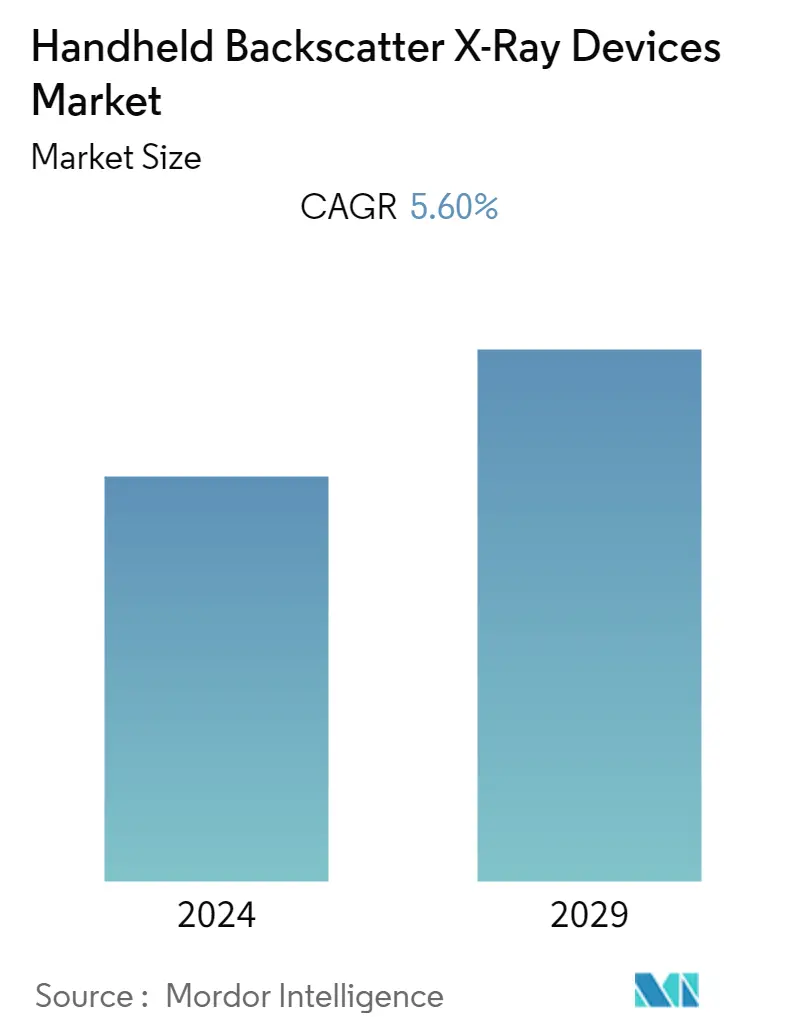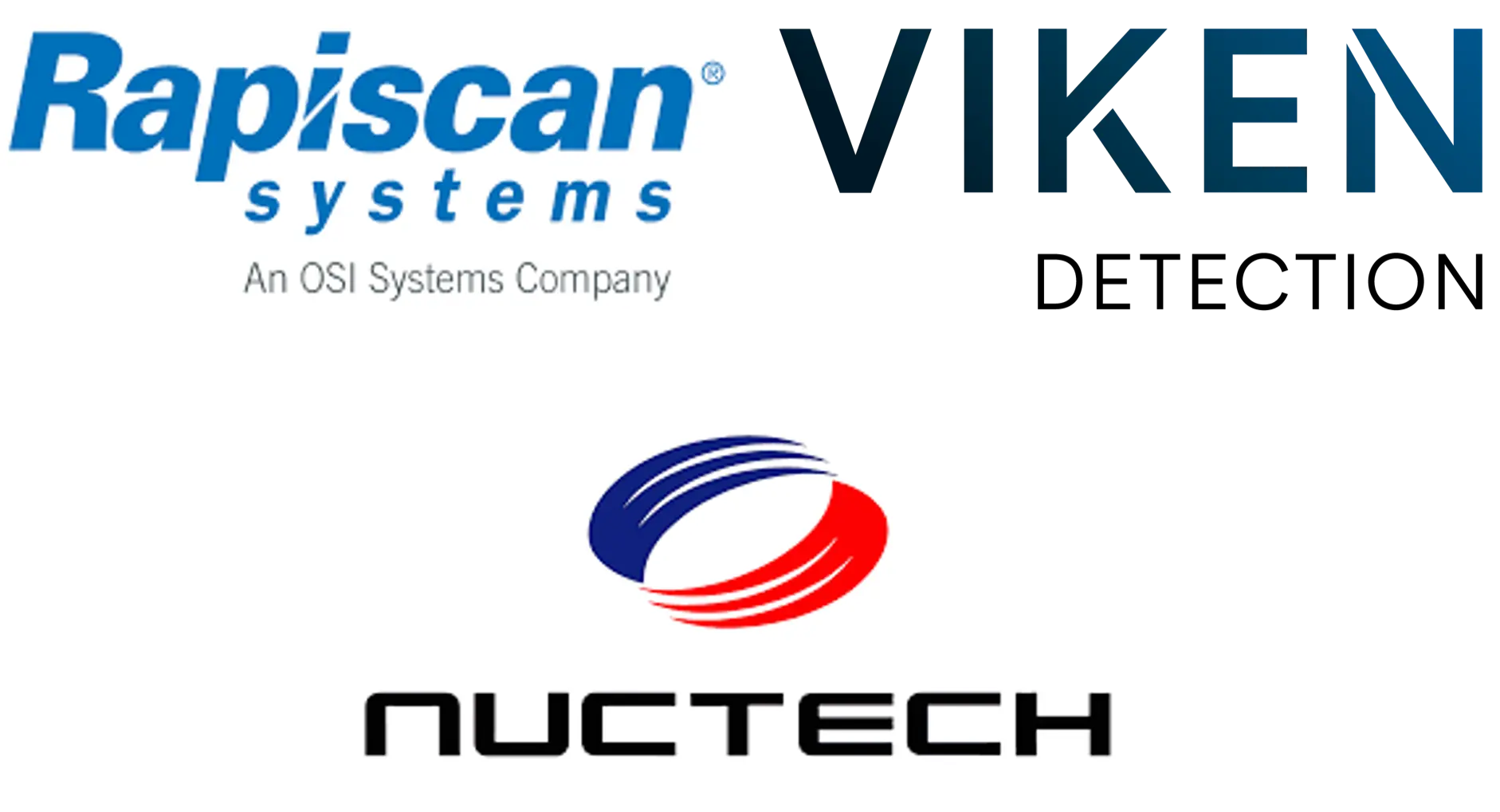Market Size of Handheld Backscatter X-Ray Devices Industry

| Study Period | 2019 - 2029 |
| Base Year For Estimation | 2023 |
| CAGR | 5.60 % |
| Fastest Growing Market | Asia Pacific |
| Largest Market | North America |
| Market Concentration | High |
Major Players
*Disclaimer: Major Players sorted in no particular order |
Handheld Backscatter X-Ray Devices Market Analysis
The Global Handheld Backscatter X-ray Devices Market was valued at USD 47.83 million in 2020, and it is expected to reach USD 67.73 million by 2026, registering a CAGR of 5.6% during the forecast period, 2021-2026.
A significant consideration to opt for a handheld version of backscatter X-ray has been observed amid the COVID-19 situations. As the police work can force officers to break that 6-foot social distance guideline, investment toward these devices helps law enforcements keep their distance. As of June 2020, Viken Detection, by building on its VALOR program, led the US-based police departments across Oklahoma, Tennessee, Mississippi, Georgia, and Indiana to training sessions in its Burlington facility on using the HBI-120 to ensure the active protection of the public from the opioid crisis amid coronavirus-led challenges.
- X-ray backscatter technology (XBT) uses scattered radiation caused by the Compton effect. The backscatter imaging involves illuminating the object with a pencil beam of known direction and collecting all the back-scattered radiation with large area detectors. The advantage of XBT lies in the inspection of an object from one side. Therefore, it is beneficial to deploy where limited access points exist or when the interior of the object is complex in terms of overlaying details.
- The trend of miniaturization of devices and ease to use have led to the development of handheld variants. These variants, though, are required to possess capabilities on-par or sometimes even sophisticated than the fixed ones. The ability to shrink the X-ray tube has been one of the primary drivers to achieve the development of handheld devices in this domain. Such advancements in the miniaturization of X-ray inspection technology have helped the upstream oil and gas sector in recent times.
- The increasing need for highly efficient and easy-to-use scanning systems is driving the market. Vehicles to screen for the detection of drugs, IEDs, to name a few, are being increasingly used across the world to smuggle in a country or region. Therefore, increased need for providing X-ray images from backscatter to detect organic-based threat materials as well, in addition to metal (lead detection), in passenger vehicles, public events, and borders are gaining traction. Also, these handheld devices/equipment offer a better return on investment (ROI).
- Countries like Islamic Republic of Iran and Morocco, reported multiple large drug seizures, indicating that large-scale drug trafficking is taking place amid the COVID-19 led restrictions, also reported an increase in interdiction resulting from increased controls. The convenience offered by handheld backscatter X-Ray devices would help reduce trafficking.
- The handheld backscatter X-ray device costs significantly higher due to exceptional and proprietary advantages and the presence of a consolidated market as well. Also, while using the device for scanning more expansive areas, the power input gets easily hampered. This is because of the availability of 5W and 10W power source. The device gets heated up. Therefore, higher energy input in similar or reduced dimensions is needed. Furthermore, the ergonomic design of the product is still not standardized. The current dimensions and weight of the product are still not appropriate for personnel to hold it for a longer duration.
Handheld Backscatter X-Ray Devices Industry Segmentation
The study considers handheld backscatter X-ray equipment used for inspection applications across cargo and vehicle, mapped across several end-user industries. The market, by region, has been classified into North America, Europe, Asia-Pacific, Latin America, and the Middle East and Africa across the significant presence of drug smuggling, border protection importance, and rate of terrorism, among others as end-users.
| End User | |
| Customs and Border Protection | |
| Law Enforcement | |
| Critical Infrastructure | |
| Military and Defense | |
| Other End Users |
| Geography | |
| North America | |
| Europe | |
| Asia Pacific | |
| Latin America | |
| Middle East and Africa |
Handheld Backscatter X-Ray Devices Market Size Summary
The handheld backscatter X-ray devices market is experiencing growth driven by the increasing demand for efficient and portable scanning systems. These devices utilize X-ray backscatter technology, which allows for the inspection of objects from one side, making them ideal for areas with limited access or complex interiors. The trend towards miniaturization has led to the development of handheld variants that offer capabilities comparable to fixed devices. This advancement is particularly beneficial in sectors such as law enforcement and border protection, where maintaining distance during inspections is crucial, especially in the context of the COVID-19 pandemic. The market is characterized by a consolidated landscape with key players like Rapiscan and Viken Detection leading the charge in innovation and deployment.
The market's expansion is further fueled by the rising need to combat illicit activities such as drug trafficking and smuggling, with handheld backscatter X-ray devices playing a vital role in enhancing national security. These devices are increasingly deployed by customs and border protection agencies, particularly in North America, to screen vehicles and detect contraband. The high cost of these devices is offset by their exceptional capabilities and return on investment. Despite challenges such as power input limitations and ergonomic design issues, the market is poised for growth as companies continue to invest in research and development to explore new applications and expand their geographical presence, particularly in the Asia Pacific region.
Handheld Backscatter X-Ray Devices Market Size - Table of Contents
-
1. MARKET DYNAMICS
-
1.1 Market Overview
-
1.2 Industry Attractiveness - Porter's Five Forces Analysis
-
1.2.1 Bargaining Power of Suppliers
-
1.2.2 Bargaining Power of Buyers
-
1.2.3 Threat of New Entrants
-
1.2.4 Threat of Substitutes
-
1.2.5 Intensity of Competitive Rivalry
-
-
1.3 Go-to-Market Strategy (Product-Market Fit, Audience/Buyer Personas, Competitive Landscape, Sales Strategies)
-
1.4 Impact of COVID-19 on the Market
-
1.5 Market Drivers
-
1.5.1 Increasing Need for Highly Efficient and Easy-to-use Scanning Systems
-
-
1.6 Market Challenges
-
1.6.1 High Cost and Need for Ergonomically Designed Equipment
-
-
-
2. MARKET SEGMENTATION
-
2.1 End User
-
2.1.1 Customs and Border Protection
-
2.1.2 Law Enforcement
-
2.1.3 Critical Infrastructure
-
2.1.4 Military and Defense
-
2.1.5 Other End Users
-
-
2.2 Geography
-
2.2.1 North America
-
2.2.2 Europe
-
2.2.3 Asia Pacific
-
2.2.4 Latin America
-
2.2.5 Middle East and Africa
-
-
Handheld Backscatter X-Ray Devices Market Size FAQs
What is the current Handheld Backscatter X-Ray Devices Market size?
The Handheld Backscatter X-Ray Devices Market is projected to register a CAGR of 5.60% during the forecast period (2024-2029)
Who are the key players in Handheld Backscatter X-Ray Devices Market?
Rapiscan Systems Inc. (a part of OSI Sytems Inc.), Viken Detection (formerly Heuresis Inc.) and Nutech Company Limited are the major companies operating in the Handheld Backscatter X-Ray Devices Market.

